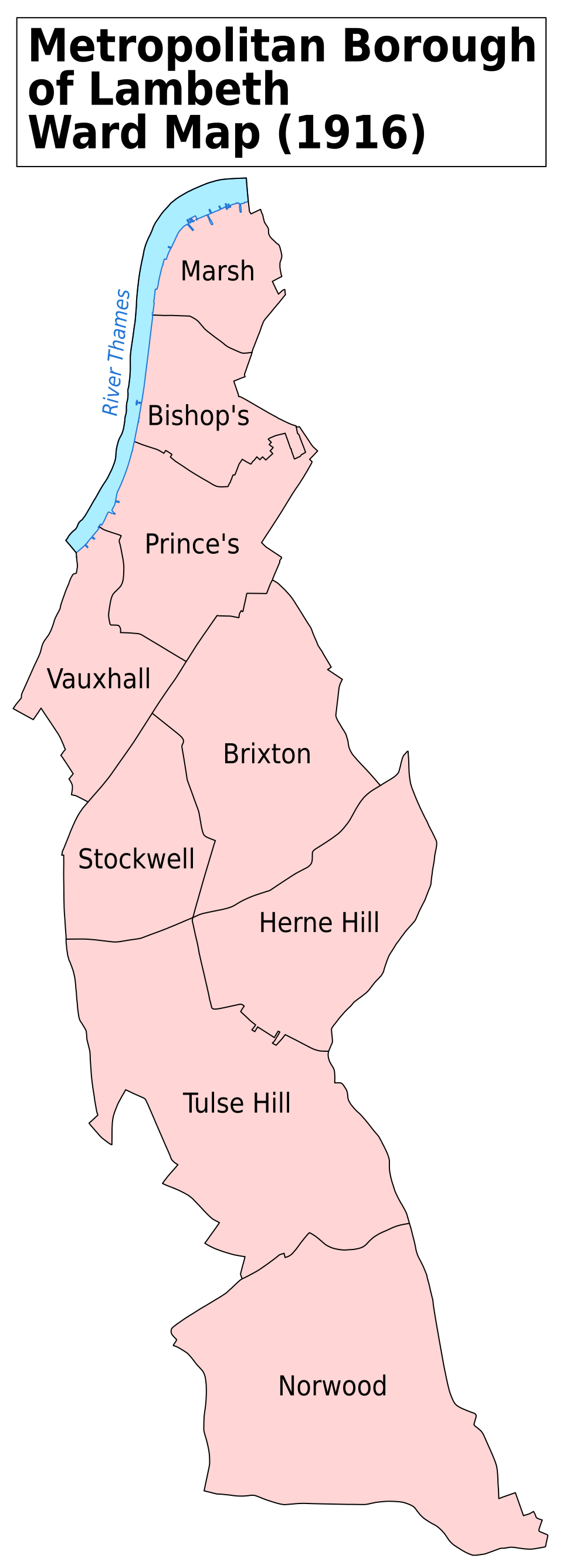Metropolitan Borough of Lambeth
Lambeth (/ˈlæmbəθ/ (listen)) is a London borough in South London, England, which forms part of Inner London. Its name was recorded in 1062 as Lambehitha ("landing place for lambs") and in 1255 as Lambeth. The geographical centre of London is at Frazier Street near Lambeth North tube station, though nearby Charing Cross on the other side of the Thames in the City of Westminster is traditionally considered the centre of London.
History
Lambeth was part of the large ancient parish of Lambeth St Mary, the site of the archepiscopal Lambeth Palace, in the hundred of Brixton in the county of Surrey.[5] It was an elongated north-south parish with 2 miles (3.2 km) of River Thames frontage opposite the cities of London and Westminster. Lambeth became part of the Metropolitan Police District in 1829. It remained a parish for Poor Law purposes after the Poor Law Amendment Act 1834, and was governed by a vestry after the introduction of the Metropolitan Board of Works in 1855.
Borough origins
Until 1889, Surrey included the present-day London borough of Lambeth. When it drew the boundaries for the London boroughs, the government initially suggested that the Metropolitan Borough of Lambeth and the Metropolitan Borough of Southwark be merged into a new borough; the southern and eastern sections of the Metropolitan Borough of Wandsworth (including Clapham, Streatham and Tooting) would form another. South Shields town clerk R.S. Young was commissioned to make final recommendations to the government on the shape of the future London boroughs, and he noted that the Wandsworth council opposed the partition of their borough. However, Wandsworth's suggestion to merge Lambeth with the Metropolitan Borough of Battersea was rejected by both councils involved. Young believed that residents of Clapham and Streatham would be more familiar with Brixton than with Wandsworth, and recommended a new borough formed from the Metropolitan Borough of Lambeth and six wards and portions of two others from the Metropolitan Borough of Wandsworth.
Geography
Lambeth is a long, thin borough, about 3 miles (4.8 km) wide and 7 miles (11 km) long. Brixton is its civic centre, and there are other town centres. The largest shopping areas are (in order of size) Streatham, Brixton, Vauxhall, Clapham and West Norwood.
In the northern part of the borough are the central London districts of the South Bank, Vauxhall and Lambeth; in the south are the suburbs of Gipsy Hill, Streatham, West Dulwich and West Norwood. In between are the developed and inner-city districts of Brixton, Brixton Hill, Streatham Hill, Clapham, Clapham Park, Herne Hill, Stockwell, Tulse Hill and Kennington, each at different stages of gentrification with suburban and urban elements. Vauxhall and South Lambeth are central districts in the process of redevelopment with high-density business and residential property. Streatham lies between suburban London and inner-city Brixton, with the suburban and developed areas of Streatham, Streatham Hill and Streatham Vale.
The London Borough of Southwark lies to the east of the Borough of Lambeth. To the west is the London Borough of Wandsworth; to the south-west is the London Borough of Merton; and to the south is the London Borough of Croydon.
Landmarks
Along and around the South Bank, a tourist area has developed around the former Greater London Council headquarters of County Hall and the Southbank Centre and National Theatre. Also on the river is the London Eye and Shell Centre. Nearby is St Thomas' Hospital, Lambeth Palace and the Florence Nightingale Museum. Nearby is Brixton, home of Lambeth Town Hall and the Brixton Murals.
- Sunlight Laundry
Landmark church buildings Include
- St Mary Lambeth (now the Garden Museum)
- The four "Waterloo Churches" in the former Lambeth Parish:
- St Matthew, Brixton
- St Mark, Kennington
- St Luke, West Norwood
- St John, Waterloo
- St Oswald's Parish Church, Norbury
- Holy Trinity, Clapham
- St Leonard, Streatham
- Christ Church, Streatham Hill
- Christ Church (Church of England), Brixton Road, North Brixton
- All Saints' Church, West Dulwich (Church of England)
- Holy Trinity, Trinity Rise, Tulse Hill
- St John the Divine (Church of England), Vassall Road
Bridges and tunnels
- Waterloo Bridge, incorporating the NFT
- Hungerford Bridge and its two pedestrian spans, the Golden Jubilee Bridges
- Lambeth Bridge
- Westminster Bridge
- Vauxhall Bridge
Railway stations
- Brixton
- Gipsy Hill
- Herne Hill
- Loughborough Junction
- Streatham
- Streatham Common
- Streatham Hill
- Tulse Hill
- Vauxhall
- Waterloo
- Waterloo East
- West Norwood
Resident Kindred
